Information
Gansu-Qinghai Grand Loop Study Tour (7 Nights/8 Days)
Serial Number: Price: RMB
Classification:
Highlights of the study tour:
1. 【Cultural Connotation】Experience the Silk Road culture + nomadic culture of the grasslands + plateau landforms + the rise of empires under the fusion of tribal ethnicities;
2.【Geographical Spectacle】Spanning three major climate zones: temperate monsoon, high plateau cold, and northwest desert, traversing the Qinghai-Tibet Plateau + Hexi Corridor;
Gathering rich and diverse geographical landscapes such as snow-capped mountains, grasslands, deserts, lakes, Gobi, and Danxia.
3.【Unique Experience】This product combines the characteristics of family parent-child study tours, adding local unique experience projects, allowing for a deep experience of local folk culture while enhancing parent-child relationships during travel.
4.【Professional Service】Private customized products, in-depth pure play, no shopping; crafted by a professional team; comprehensive service upgrade;
Selected unique hotels
Recommended local specialty cuisine
Professional drivers and guides provide full support throughout the journey
Easy and reasonable itinerary arrangement
Professional travel guidance services
Itinerary Overview:
Day 1: Beijing - Lanzhou (70KM, about 1 hour by car) including lunch
Self-arranged transfer to the airport for the flight to Lanzhou, then take a car to Lanzhou city (about 1.5 hours). After arrival, visit the Gansu Provincial Museum, a national first-class museum with a rich collection, focusing on the Silk Road Hall and the Colored Pottery Hall to learn about Silk Road culture and early colored pottery culture; then tour the Yellow River Hundred Miles Scenic Line, Zhongshan Bridge, Waterwheel Expo Park, and the Yellow River Mother statue, with free time to play by the river.
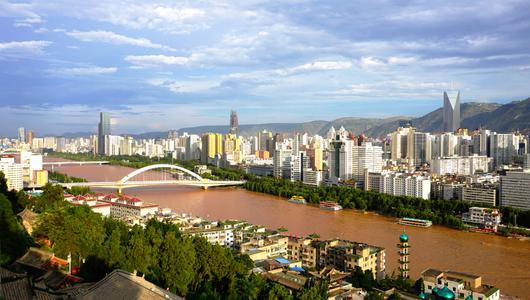
Yellow River Hundred Miles Scenic Line - Zhongshan Bridge
Day 2: Lanzhou - Xining (250KM, about 1.2 hours by high-speed train) - Ta'er Temple - Jinyintan Grassland - Qinghai Lake (150KM, about 1.5 hours by car) including lunch
*** Today's study tour focus:
1. Understand the profound and extensive culture of Tibetan Buddhism and the far-reaching impact of religious beliefs on a nation and an individual;
2. Enjoy the grasslands, get close to nature, and experience the true beauty of nature;
After breakfast, take a train to the provincial capital of Qinghai -- Xining, located on the eastern edge of the Qinghai-Tibet Plateau, with an average elevation of 2275 meters in the city. Here, winters are not harsh, and summers are not scorching, as nature has bestowed Xining with a very cool and pleasant summer, with average summer temperatures between 10-25°C, earning it the title of "China's Summer Capital."
Ta'er Temple, also known as Ta'er Temple, is the birthplace of Master Tsongkhapa, the founder of the Gelug school (Yellow Sect) of Tibetan Buddhism, and one of the six major monasteries of Tibetan Buddhism in China. The temple was first built in the 39th year of the Ming Jiajing era (1560 AD) and has a history of over 400 years. The entire temple complex consists of numerous halls, scripture halls, stupas, and monk residences, forming a magnificent architectural group that combines Han and Tibetan art, serving as the center of Tibetan Buddhism activities in the northwest region, and is also renowned throughout the country and Southeast Asia. The "butter flower, pile embroidery, and murals" are known as the three treasures of Ta'er Temple.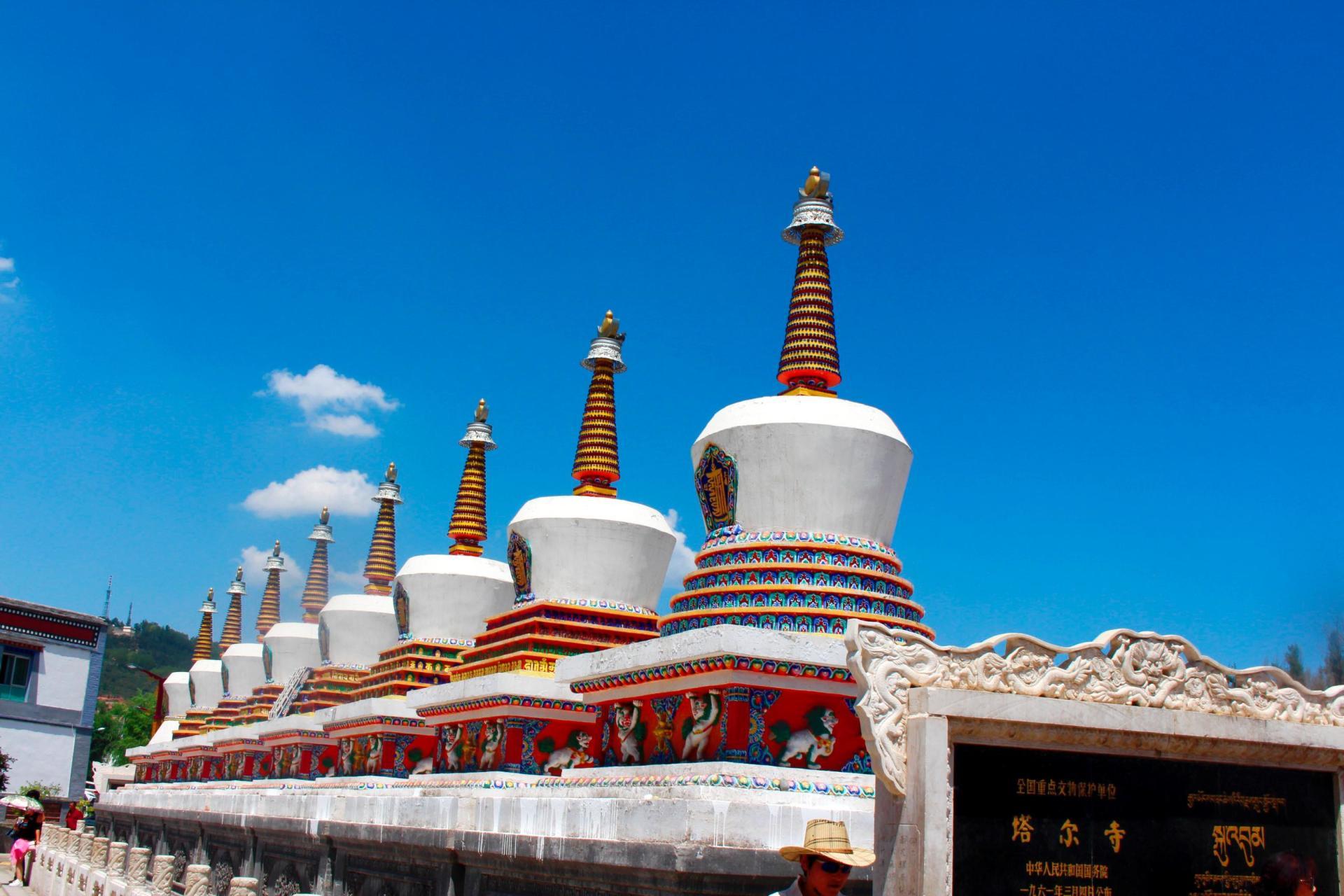
Ta'er Temple
Qinghai Lake, also known as "Cuo'embu," meaning "blue sea" in Tibetan, is not only the largest inland lake in China but also the largest saltwater lake in China. Qinghai Lake is located on the plateau, with an average daily temperature of only about 15 degrees in July and August, making it the most beautiful time for Qinghai Lake, where thousands of acres of rapeseed flowers bloom around the lake, with the azure waves surrounded by golden yellow, and the wildflowers of the highland pastures are colorful and beautiful, with countless fat and strong sheep and cattle dotting the landscape.
Jinyintan Grassland, home to the famous Golden Beach and Silver Beach grasslands, is the birthplace of the world-famous song "In That Distant Place"; it was also a little-known mysterious forbidden zone, nurturing the first atomic bomb and hydrogen bomb of New China, and is China's first nuclear weapon research base, recognized as a "National Patriotic Education Demonstration Base" and a "National Key Cultural Relics Protection Unit." Tonight, we will stay at the beautiful grassland's Tibetan family resort to experience Tibetan folk culture.
Day 3: Xining - Zhangye (360KM, about 2 hours by high-speed train) including lunch
*** Today's study tour focus:
1. Understand the formation reasons of inland lakes on the plateau and related ecological protection knowledge;
2. Understand the important geographical advantages of Ganzhou (Zhangye) during the Han and Sui-Tang dynasties and its significance to the empire;
Wake up early to watch the sunrise over Qinghai Lake, then return to Xining city by car, in the afternoon take a train to Zhangye, after arrival adjust and rest, with free time in the evening to explore the Zhangye food street.
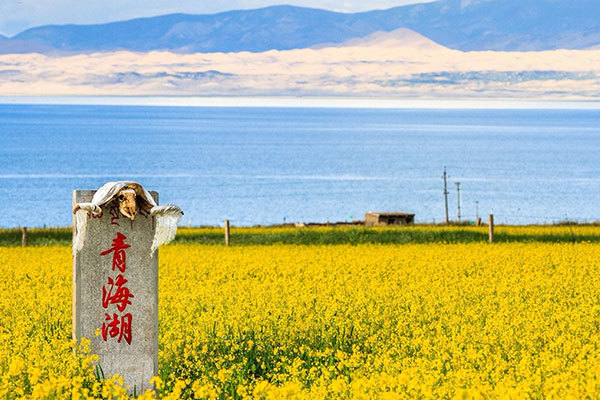
Qinghai Lake
Day 4: Zhangye Day Tour including lunch
*** Today's study tour focus:
1. Understand the culture of the Western Xia and the historical changes of the Dangxiang people in ancient China;
2. Geological textbook -- understand and analyze the reasons for the formation of different Danxia landforms in Zhangye and the characteristics of the geological landscape;
Zhangye Danxia National Geological Park, mainly divided into the Binggou Danxia Scenic Area and the Colorful Danxia Scenic Area. The Colorful Danxia Scenic Area is famous for its "colorful" features, while the Binggou Danxia is known for its "majestic and magical" qualities, earning the nickname "Red Cliffs of a Thousand Fathoms," and is rated as one of the "Top Ten Geographical Wonders of the World."
The Binggou Danxia Scenic Area, as an ancient geological relic, originates from the horizontal or gently sloping red strata of the Jurassic to Tertiary period. It is a red rock system formed during the Himalayan orogeny. With the uplift of the crust, the slopes have retreated mainly through collapse processes, leaving behind isolated strange rocks formed by long-term weathering and erosion of the red sandstone, hence its prominent feature of "color like wet dan, brilliant as bright clouds."
The Qicai Danxia Geological Park is the only composite area of Danxia landform and colorful hilly landscape in the country, rated as one of the seven most beautiful Danxia landforms in China by "China National Geography" magazine. The colorful mountains here were the filming location for Zhang Yimou's movie "A Simple Noodle Story," attracting countless tourists due to their vibrant colors.

“Danxia" refers to isolated peaks and steep strange rocks formed by long-term weathering and erosion of red sandstone. The grandeur of Zhangye Danxia, the spectacular scenes, the unique shapes, and the brilliant colors are astonishing, making it the most typical Danxia landform in China's arid regions. This place serves as a practical teaching site for students to understand geological landforms and for geological researchers.
Day 5: Zhangye - Jiayuguan (260KM, about 3 hours by car) including lunch.
*** Today's study tour focus:
Deeply understand the long history of the Great Wall culture, frontier culture, and its importance in military aspects.
Jiayuguan, standing majestically between the Qilian snow peaks and the Black Mountain, is steep and grand, earning the title of "the first pass under heaven." Since the Qin and Han dynasties, various dynasties have built fortifications here, leaving numerous ancient sites and precious cultural relics. The Jiayuguan city wall has 14 structures including arrow towers, enemy towers, corner towers, pavilions, and gate towers, with a clever architectural layout and imposing grandeur. Visit the Great Wall Museum to learn about Great Wall culture, and personally experience the majestic desolation of the Ming Great Wall as the sun sets.
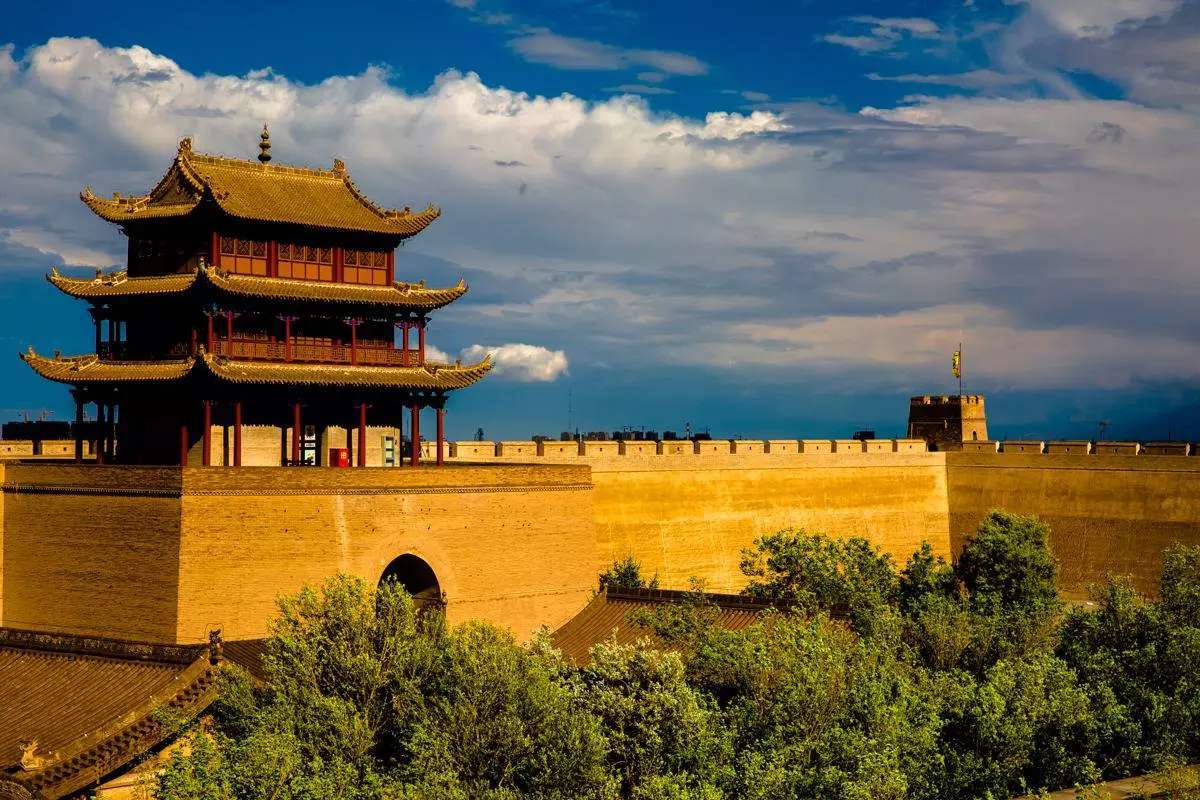
The Hanging Great Wall, located 8 kilometers north of Jiayuguan city, on the north slope of the Black Mountain at the Shiguan Gorge. In the 18th year of the Jiajing era (1539), to strengthen the defense of Jiayuguan, Li Han, the military governor of Suzhou, began to build a 15-kilometer-long stone wall on the mountain top south of the gorge. The project was completed in the 19th year of Jiajing (1540), making the defense of the pass more secure, and it was known as the "Broken Wall Great Wall." Because the wall drops steeply from the mountain, it appears to hang upside down on the ridge, hence the colloquial name "Hanging Great Wall."
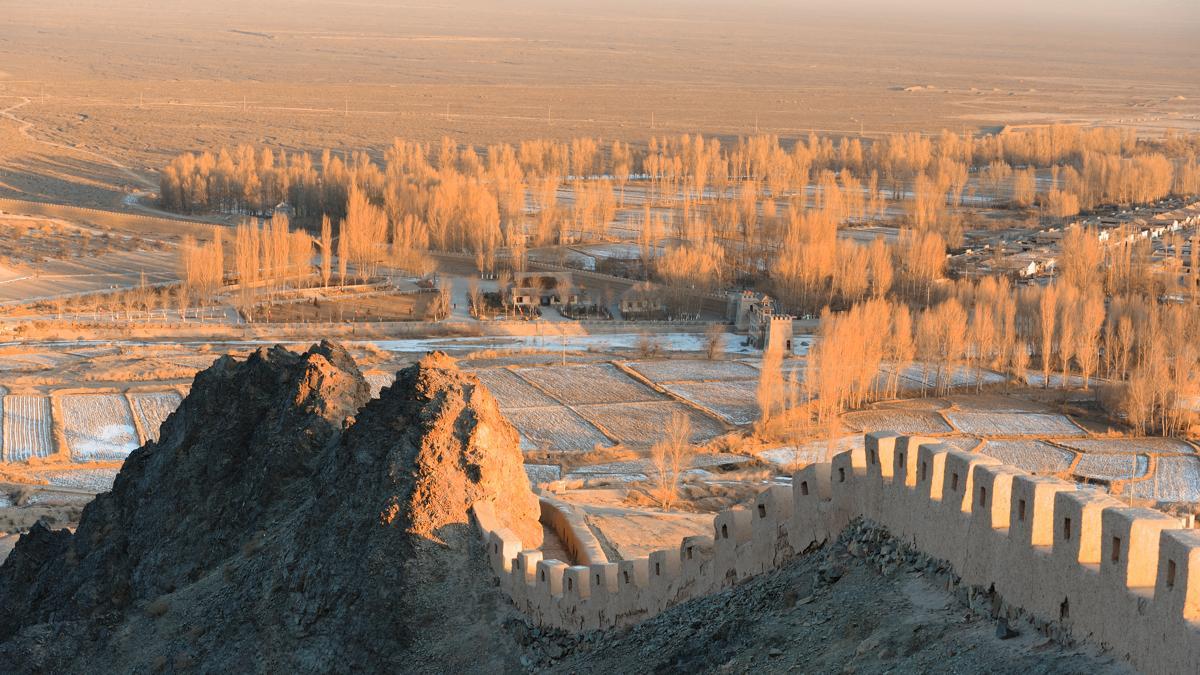
Day 6: Jiayuguan - Dunhuang (390KM, about 4.5 hours by car) including lunch.
*** Today's study tour focus:
Recite frontier poetry, reflect on the past, and experience the charm and artistic conception of ancient poetry.
Yangguan is a vital land route for ancient external communication in China and a necessary pass on the southern Silk Road. It was established during the Western Han dynasty and named because it is south of the Yumenguan Pass. Yangguan and Yumenguan were both gateways to the Western Regions at that time. After the Song dynasty, due to the gradual decline of western and land transportation, the pass was abandoned. Although the pass has been abandoned, it has left behind timeless verses.
"The Yellow River flows far above the white clouds, a lonely city stands amidst the towering mountains. Why should the Qiang flute complain about the willows? The spring breeze does not cross the Yumenguan Pass."
"Morning rain in Weicheng moistens the light dust, the guesthouse is green with new willow color. I urge you to drink another cup of wine, for there are no old friends west of Yangguan."
"Grape wine in a night-glowing cup, eager to drink as the pipa urges on horseback. Do not laugh at me for drunkenly lying on the battlefield, for how many have returned from ancient battles?"
In the evening, watch the performance of "Again Seeing Dunhuang," experiencing the rise and fall of the Silk Road in real life, preparing thoroughly for the visit to the Mogao Caves the next day.
Day 7: One-day tour of Dunhuang including lunch (you can choose to get up early to watch the sunrise at the Mingsha Mountain or watch the sunset later, free choice).
*** Today's study tour focus:
1. Hiking at Mingsha Mountain, cultivating students' spirit of not fearing hardship, being innovative, and selflessly dedicated.
2. Understand the special formation reasons of Crescent Spring and the measures taken by the country to save it.
3. Through visiting the Mogao Caves, gain a deep understanding of the history of the Silk Road and feel the charm of Dunhuang culture and aesthetic art.
The Mogao Caves, also known as the "Caves of a Thousand Buddhas," are famous for their exquisite murals and sculptures, and are the largest, most diverse, and best-preserved treasure trove of Buddhist art in the world. They were established during the Former Qin period of the Sixteen Kingdoms and have grown in scale through the efforts of successive dynasties. There are currently 735 caves, 45,000 square meters of murals, and 2,415 clay sculptures, remaining in a corner of Dunhuang, untouched by time and untainted by prosperity, yet forever the unparalleled pride of Dunhuang, to be admired but not compared.
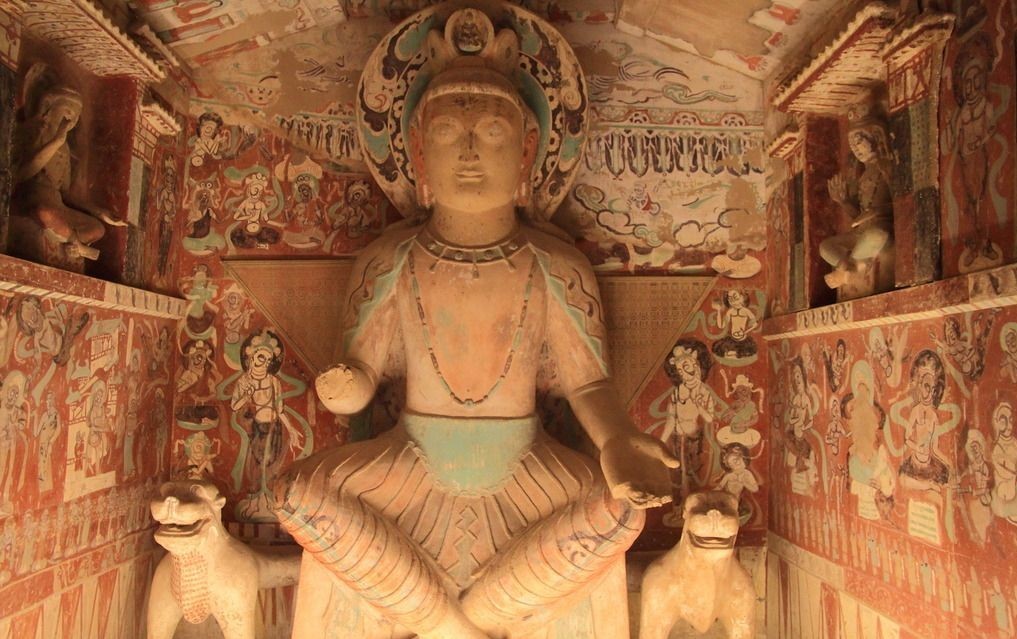
Mingsha Mountain and Crescent Spring are a pair of twin sisters in the desert, the mountain is named for its spirit, and the water is enhanced by its divinity. Mingsha Mountain is surrounded by a pool of blue water shaped like a crescent moon, the spring flows through the sand, never drying up in drought, the wind blows the sand without falling, and the spring reflects the moon without dust. Explore the three treasures of Crescent Spring and ecological protection issues.

Day 8: Dunhuang - Beijing (Breakfast)

